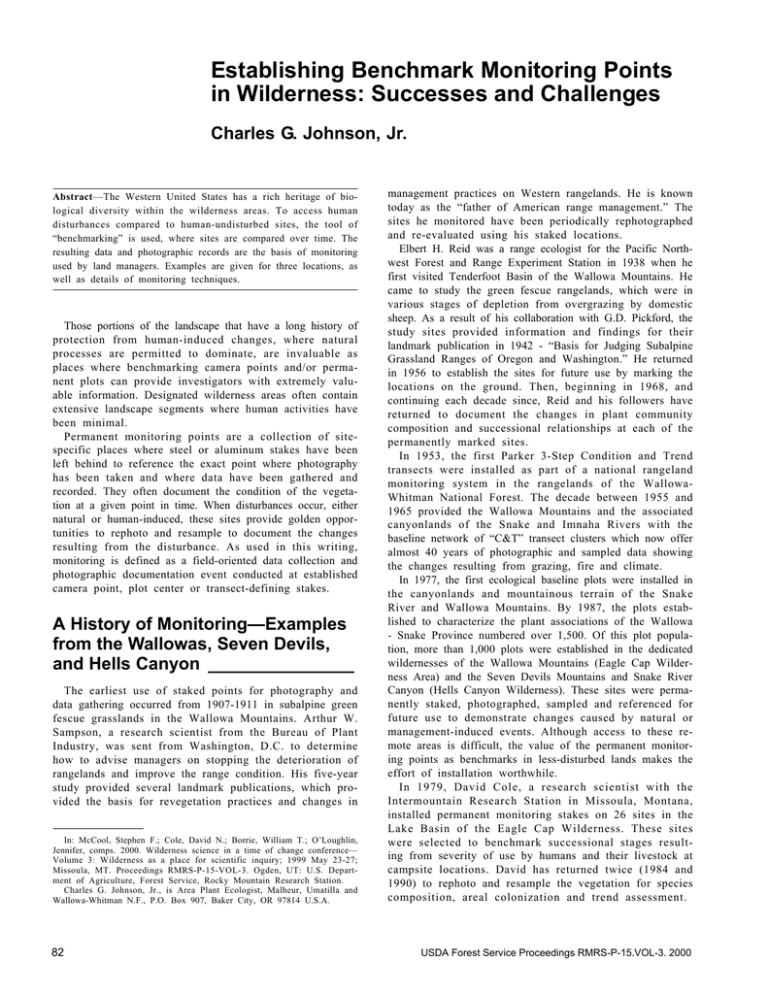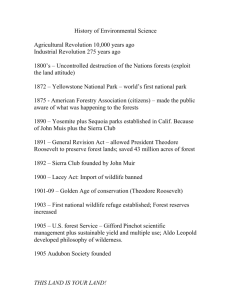Establishing Benchmark Monitoring Points in Wilderness: Successes and Challenges
advertisement

Establishing Benchmark Monitoring Points in Wilderness: Successes and Challenges Charles G. Johnson, Jr. Abstract—The Western United States has a rich heritage of biological diversity within the wilderness areas. To access human disturbances compared to human-undisturbed sites, the tool of “benchmarking” is used, where sites are compared over time. The resulting data and photographic records are the basis of monitoring used by land managers. Examples are given for three locations, as well as details of monitoring techniques. Those portions of the landscape that have a long history of protection from human-induced changes, where natural processes are permitted to dominate, are invaluable as places where benchmarking camera points and/or permanent plots can provide investigators with extremely valuable information. Designated wilderness areas often contain extensive landscape segments where human activities have been minimal. Permanent monitoring points are a collection of sitespecific places where steel or aluminum stakes have been left behind to reference the exact point where photography has been taken and where data have been gathered and recorded. They often document the condition of the vegetation at a given point in time. When disturbances occur, either natural or human-induced, these sites provide golden opportunities to rephoto and resample to document the changes resulting from the disturbance. As used in this writing, monitoring is defined as a field-oriented data collection and photographic documentation event conducted at established camera point, plot center or transect-defining stakes. A History of Monitoring—Examples from the Wallowas, Seven Devils, and Hells Canyon _______________ The earliest use of staked points for photography and data gathering occurred from 1907-1911 in subalpine green fescue grasslands in the Wallowa Mountains. Arthur W. Sampson, a research scientist from the Bureau of Plant Industry, was sent from Washington, D.C. to determine how to advise managers on stopping the deterioration of rangelands and improve the range condition. His five-year study provided several landmark publications, which provided the basis for revegetation practices and changes in In: McCool, Stephen F.; Cole, David N.; Borrie, William T.; O’Loughlin, Jennifer, comps. 2000. Wilderness science in a time of change conference— Volume 3: Wilderness as a place for scientific inquiry; 1999 May 23-27; Missoula, MT. Proceedings RMRS-P-15-VOL-3. Ogden, UT: U.S. Department of Agriculture, Forest Service, Rocky Mountain Research Station. Charles G. Johnson, Jr., is Area Plant Ecologist, Malheur, Umatilla and Wallowa-Whitman N.F., P.O. Box 907, Baker City, OR 97814 U.S.A. 82 management practices on Western rangelands. He is known today as the “father of American range management.” The sites he monitored have been periodically rephotographed and re-evaluated using his staked locations. Elbert H. Reid was a range ecologist for the Pacific Northwest Forest and Range Experiment Station in 1938 when he first visited Tenderfoot Basin of the Wallowa Mountains. He came to study the green fescue rangelands, which were in various stages of depletion from overgrazing by domestic sheep. As a result of his collaboration with G.D. Pickford, the study sites provided information and findings for their landmark publication in 1942 - “Basis for Judging Subalpine Grassland Ranges of Oregon and Washington.” He returned in 1956 to establish the sites for future use by marking the locations on the ground. Then, beginning in 1968, and continuing each decade since, Reid and his followers have returned to document the changes in plant community composition and successional relationships at each of the permanently marked sites. In 1953, the first Parker 3-Step Condition and Trend transects were installed as part of a national rangeland monitoring system in the rangelands of the WallowaWhitman National Forest. The decade between 1955 and 1965 provided the Wallowa Mountains and the associated canyonlands of the Snake and Imnaha Rivers with the baseline network of “C&T” transect clusters which now offer almost 40 years of photographic and sampled data showing the changes resulting from grazing, fire and climate. In 1977, the first ecological baseline plots were installed in the canyonlands and mountainous terrain of the Snake River and Wallowa Mountains. By 1987, the plots established to characterize the plant associations of the Wallowa - Snake Province numbered over 1,500. Of this plot population, more than 1,000 plots were established in the dedicated wildernesses of the Wallowa Mountains (Eagle Cap Wilderness Area) and the Seven Devils Mountains and Snake River Canyon (Hells Canyon Wilderness). These sites were permanently staked, photographed, sampled and referenced for future use to demonstrate changes caused by natural or management-induced events. Although access to these remote areas is difficult, the value of the permanent monitoring points as benchmarks in less-disturbed lands makes the effort of installation worthwhile. In 1979, David Cole, a research scientist with the Intermountain Research Station in Missoula, Montana, installed permanent monitoring stakes on 26 sites in the Lake Basin of the Eagle Cap Wilderness. These sites were selected to benchmark successional stages resulting from severity of use by humans and their livestock at campsite locations. David has returned twice (1984 and 1990) to rephoto and resample the vegetation for species composition, areal colonization and trend assessment. USDA Forest Service Proceedings RMRS-P-15.VOL-3. 2000 Marking significant disturbance events is one of the key values of having permanent monitoring points established and sampled prior to the unknown disturbances that befall these sites. Examples of naturally occurring disturbances in wildernesses are wildfires, grazing use by native ungulates, mass wasting events such as landslides, slumps or debris flows, and climatic changes. Examples of human-induced or nonnatural disturbances in wildernesses are domestic grazing and recreational impacts. Also of concern to the wilderness manager are lack of periodic natural disturbance events important to the ecosystems (retardation of natural fire return) and by numbers of species out-of-balance with historic levels (elk and deer populations; alien plant infestations). An example from the Hells Canyon Wilderness that demonstrates the value of permanent monitoring points occurred when the Salt Creek Burn visited 52,600 acres in 1996. The permanent monitoring points established prior to that fire were Parker Condition and Trend (C&T) transects, ecological classification plots and one three-way exclosure. Of the 76 monitoring points established within the burn area, 40 of the sites were burned and available for study of fire succession across a variety of different plant communities affecting a broad array of plant associations. Techniques Employed for Monitoring The basic concept was to locate a plant community that represents a particular seral stage of a given plant association, drive a stake into the ground at the stand center, take pictures of the desired views from that stake and collect baseline environmental and plant data. It was deemed important to reference the site for future relocation and anticipate that the next investigator would be someone unfamiliar with the previous work. Therefore, aerial photos were pin-pricked and labelled; USGS quadrangle maps were labelled; and a permanent monitoring point reference sign was placed onsite. The completed work on one permanent monitoring point did not end here. After field work was completed, the office portion of the monitoring task was begun. This involved labeling the photography, setting up a hard-copy file for the data cards, maps and photography and inputting the data into an electronic data base. In addition, the mapped locations were digitized into an electronic GIS data layer. Finally, a retake/resample “promise” system was devised to assure that the sites were revisited at a designated date in the future. Plots were sampled using two different techniques. For reconnaissance-level plots, the size was 375 square-meters (roughly one-tenth acre) in a circle, with the camera point at the center where a steel stake was driven. For photographic documentation, the investigator chose an unspecified number of views radiating from the plot center outward to the skyline (long oblique photos) and/or to the foreground (short oblique photos). For more intensively sampled sites, transects were employed, with small microplots sampled along the transect lines. Usually two 100-foot transects were placed within the general area of the reconnaissance plot. Then up to 40 microplots were sampled using one-square foot quadrats placed systematically along the two transects. In addition one-square yard quadrats were photographed at systematic locations straddling the transect lines to accompany USDA Forest Service Proceedings RMRS-P-15-VOL-3. 2000 the general views taken from the ends of the transects of the overall site. Conclusion_____________________ Designated wilderness areas provide a rich mix of forestland, shrubland, grassland and wetland ecosystems. In the western United States, topographic relief generally is a feature of either canyonland or mountainous landforms included in most designated wildernesses. This relief enhances landscape diversity and, with the varying aspects, promotes a high biological diversity for the areas. With such a rich heritage of biological diversity included within our wilderness areas, it is critical that we document the baseline ecological condition (seral stages) of the plant populations and plant communities. From this baseline of “benchmark” plots and camera points, land managers can utilize the photographic and sampled data to enhance the management of our wilderness areas. References _____________________ Cole, David N. 1982. Wilderness campsite impacts: effect of amount of use. Res. Paper INT-302. Ogden, Utah: U.S. Department of Agriculture, Forest Service, Intermountain Forest and Range Experiment Station. 42 p. Cole, David N. 1986. Ecological changes on campsites in the Eagle Cap Wilderness, 1979 to 1984. Res. Paper INT-368. Ogden, Utah: U.S. Department of Agriculture, Forest Service, Intermountain Research Station. 15 p. Cole, David N.; Hall, Troy E. 1992. Trends in campsite condition:Eagle Cap Wilderness, Bob Marshall Wilderness, and Grand Canyon National Park. Res. Paper INT- 453. Ogden, Utah: U.S. Department of Agriculture, Forest Service, Intermountain Research Station. 40 p. Cole, David N. 1993. Campsites in three western wildernesses:proliferation and changes in condition over 12 to 16 years. Res. Paper INT-463. Ogden, Utah: U.S. Department of Agriculture, Forest Service, Intermountain Research Station. 15 p. Johnson, C. G. Jr.; Simon, S. A. 1987. Plant Associations of the Wallowa-Snake Province. R6-ECOL-TP-225A-86. Portland, Oregon. U.S. Department of Agriculture, Forest Service, Pacific Northwest Region. 399 p. Pickford, G. D.; Reid, E. H. 1942. Basis for judging subalpine grassland ranges of Oregon and Washington. U.S. Dept. of Agric. Circular 655. 38 p. Reid, E. H.; Strickler, G. S.; Hall, W. B. 1980. Green fescue grassland: 40 years of secondary succession. Res. Paper PNW-274. Portland, Oregon: U.S. Department of Agriculture, Forest Service, Pacific Northwest Forest and Range Experiment Station. 39 p. Reid, E. H.; Johnson, Jr., C. G.; Hall, W. B. 1991. Green fescue grassland: 50 years of secondary succession under sheep grazing. R6-F16-SO-0591. Portland, Oregon: U.S. Department of Agriculture, Forest Service, Pacific Northwest Forest and Range Experiment Station. 37 p. Sampson, A. W. 1908. The revegetation of overgrazed areas. Preliminary report. Forest Service Circular 158. U.S. Department of Agriculture, Washington, D.C. 21 p. Sampson, A. W. 1909. Natural revegetation of depleted mountain grazing lands. Forest Service Circular 169. U.S. Department of Agriculture, Washington, D.C. 28 p. Sampson, A. W. 1914. Natural vegetation of rangelands based upon growth requirements and life history of the vegetation. Journal of Agriculture Research 3(2);93-147. Strickler, G. S.; Hall, W. B. 1980. The Standley Allotment: A History of Range Recovery. Res. Paper PNW-278. Portland, Oregon: U.S. Department of Agriculture, Forest Service, Pacific Northwest Forest and Range Experiment Station. 35 p. 83



